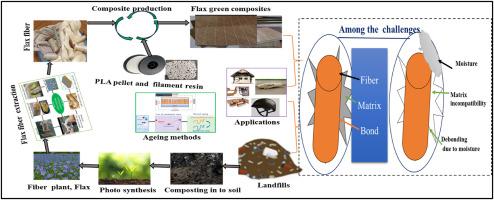A review of flax fiber reinforced polylactic acid composites as green polymeric materials: Ageing properties, sustainability, challenges and future perspectives
IF 7.9
3区 材料科学
Q1 GREEN & SUSTAINABLE SCIENCE & TECHNOLOGY
引用次数: 0
Abstract
Synthetic fiber composites (SFCs) have various engineering applications because of their high mechanical performance with lightweight characteristics. However, their un eco-friend and unsustainability behavior led to a shift towards green composites. Yet, the qualities of NFCs have its own limitations due to its hydrophilic nature and low thermal stability issue. Therefore, natural fibers have been chemically treated to improve these constraints for better performances, however, on the other hand these chemicals will challenges the greening environment. Thus, after use, composite materials should be aged and composited in to environment for better ecosystem. When green composites are exposed to some external ageing conditions its properties will become degraded. Therfore, this review targets to show natural fiber reinforced polymeric composites, (specifically flax reinforced polylactic acid composites) are greener and more sustainable than synthetic fiber composites with more specific and detailed ways compared to that of related documented reviews. The moisture and hydrothermal accelerated aging methods were focused to analysis ageing properties of the flax-bio composites. This review research showed, the degree of greenness of the polymeric composites could depend on the specific reinforcing fiber types, its quantity of environmental impact in its life cycle and the matrix material properties used in the composites. Furthermore, the applications of flax composites in several areas were described. Finally, the review summarizes the findings of the existing literature and has suggested key insights for possible future consideration in the field.

亚麻纤维增强聚乳酸复合材料作为绿色高分子材料的研究进展:老化性能、可持续性、挑战和未来展望
合成纤维复合材料(sfc)由于具有高机械性能和轻量化的特点,在工程上有着广泛的应用。然而,它们的不环保和不可持续性行为导致了向绿色复合材料的转变。然而,由于其亲水性和低热稳定性问题,nfc的性能有其自身的局限性。因此,对天然纤维进行化学处理以改善这些限制以获得更好的性能,然而,另一方面,这些化学物质将挑战绿化环境。因此,复合材料在使用后应进行老化和复合,以达到更好的生态环境。当绿色复合材料暴露在某些外部老化条件下时,其性能会退化。因此,与相关文献综述相比,本文旨在从更具体、更详细的角度说明天然纤维增强聚合物复合材料(特别是亚麻增强聚乳酸复合材料)比合成纤维复合材料更环保、更可持续。研究了湿法和水热加速老化法对亚麻-生物复合材料老化性能的影响。研究表明,聚合物复合材料的绿色程度取决于增强纤维的具体种类、增强纤维在其生命周期中对环境的影响程度以及复合材料所使用的基体材料性能。介绍了亚麻复合材料在几个领域的应用。最后,综述总结了现有文献的发现,并提出了该领域未来可能考虑的关键见解。
本文章由计算机程序翻译,如有差异,请以英文原文为准。
求助全文
约1分钟内获得全文
求助全文
来源期刊

Materials Today Sustainability
Multiple-
CiteScore
5.80
自引率
6.40%
发文量
174
审稿时长
32 days
期刊介绍:
Materials Today Sustainability is a multi-disciplinary journal covering all aspects of sustainability through materials science.
With a rapidly increasing population with growing demands, materials science has emerged as a critical discipline toward protecting of the environment and ensuring the long term survival of future generations.
 求助内容:
求助内容: 应助结果提醒方式:
应助结果提醒方式:


